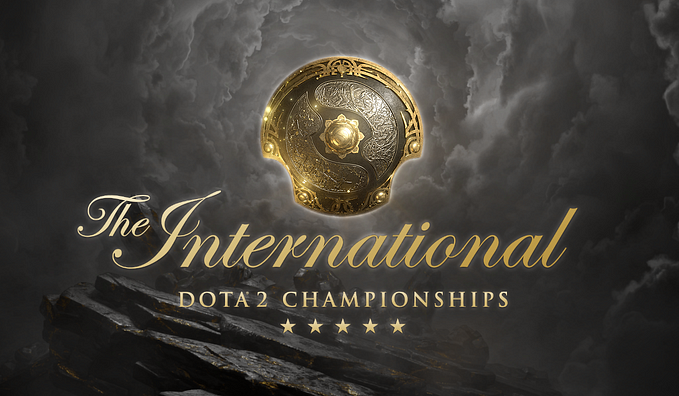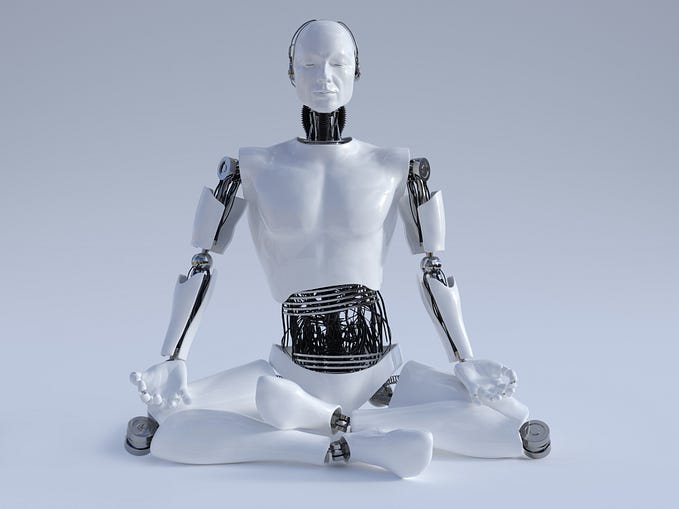The International 2024 Teams and Meta Overview
Not much time left until The International 2024 kicks off so it’s time to make a quick review of stats of the teams and overall meta going into this event. And it’s definitely not late because yours truly was playing Deadlock this whole time and could not catch a break.

Update: I got so lost in preparations for The International this time, that I was not able to finish this blog post in time. At the time of writing this note, it’s 1am already and there’s only 25% of the blog post ready. So by my estimation, it should be finished by the end of the first day of Group Stage. And translated throughout the second day.
This time there are three reports worth looking into:
- TI13 Regional Qualifiers Report
- Pre-TI13 Teams Recap, covering last 4 months of Tier 1 competitive games played by TI13 attending teams
- Pre-TI13 Ranked Recap, covering last 3 weeks of Ranked matches, played by TI13 players
There aren’t many new exciting features this time, since most of the focus this year went into stability improvements and quality of life features in the reports, so it will be easier to navigate. But there are still some experimental features available for Early Preview subscribers (on Patreon/Boosty).
And as always it’s worth checking out these great resources:
- My TI13 reports hub — all reports for this TI will be there
- Tsunami’s TI13 Team Guide — my favorite kind of breakdown, highly recommend to read it
- TI13 Liquipedia page
- Noxville’s blog post for BO3
This time around I don’t think there is much value in talking about qualifiers. The biggest focus below will be on the Ranked meta of 7.37c, going straight into the teams breakdown.
One thing to note is that this series of team previews were never about any sort of performance analytics and such, but rather a quick overview of how the teams performed prior to the event, what they are focusing on right now and what are the things to note about their playstyles. Given the tight schedule, this time there was even less time to do a deeper dive into the topic (I even considered not making such blog post at all!), so just keep this in mind.
What is going on in Ranked

The biggest thing about the Immortal Meta currently is the Heals Meta.
I like to think about the meta throughout Dota patches as “Meta Levels”. Level Zero is the most broken heroes, the origin of brokenness if you will. Level One are the heroes that are getting attention as an answer to the Level Zero meta, Level Two is the answer to Level One and so one. Essentially it’s the cycle of finding what works and what’s the answer to that.
And usually, as the meta develops, the focus of the meta slowly drifts from one level to another (and this go for a very long time).
This time the Level-0 of the meta are the healers. You know how broken was Wraith Pact two years ago? Well, Holy Locket is the same now. So as a result the strongest and probably the most popular heroes right now are the healers/savers kind: Omniknight, Tinker (his March of the Machines facet turns him into an incredible healer support), Abaddon, Treant, etc
Naturally, Level-1 of the meta are, naturally, heroes who can either focus quickly on the healer supports or shut them up: Night Stalker, Legion Commander, Clinkz, Puck, Marci, etc. Another kind of heroes that kind of belongs to this tier are heroes who benefit from enemies staying alive, like Visage, Ursa, Slark.
And Level-2 is essentially the answer to that: counter initiation and fight reset, as well as non-healing saves. Heroes like Wyvern, Weaver, Earthshaker, Axe, Naga Siren (both Core and Support, though leaning towards the latter more), Shadow Demon all look good here, while also having other benefits. With Level-3 maybe having a bigger focus on tankiness or long attack range carries.
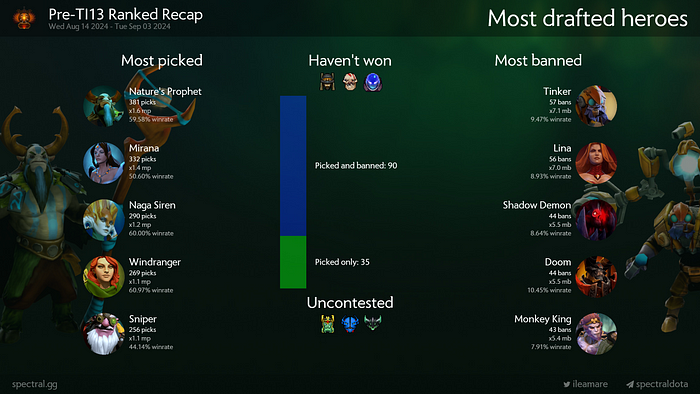
One interesting thing about the Pre-TI13 ranked meta is that TI players seem to be at Level-2 or even Level-3 at this point, focusing more on fight reset and sustain, rather than on the heals. Heroes like Tusk, Enigma, Sand King, Omniknight (who is still great at fight reset) steal the show, while the popularity of heroes like Lina, Morphling, Carry Mirana, Windranger or even Sniper doesn’t seem to be as surprising.

Did you know:
- Talon.Akashi has the highest winrate compared to all other TI13 players in the last 3 weeks: 65.25% over 72 matches (not counting players with low number of matches and smurfs)
- Davai Lama had the biggest hero pool of 41 hero over 128 matches, followed by Topson, Yatoro, MoOz and xNova, all with 35 heroes
- Players with the highest Damage to Gold ratios are 7e (1.48), Topson (1.43) and Nine (1.41)
- Davail Lama is also the player with the highest number of average map pings per minute (3.52), followed by Lumpy (3.45) and Munkushi (2.89)
- Fishman had the highest average number of death, but also the most total buybacks in his 90 matches
Teams

A few explanations before we roll:
- Diversity is a new metric, described here. It represents how diverse the team’s picks are each game
- Special Heroes are heroes specific for this team, meaning this team picked these heroes more than most other teams
And, as usual, you can explore all the stats and full profiles here: https://stats.spectral.gg/lrg2/?league=pre_ti13
Also, don’t pay too much attention to the player photos, as some of them might be outdated or lacking. Not that I’m too lazy to update it, more like there weren’t any good sources to update/add the photos from, and the older ones still do the job.
G2.IG

G2.IG is one of the oldest orgs in Dota 2 and the current roster is keeping up with the task of continuing the legacy of such a legendary tag. This team pretty much consists of five young and promising Chinese legends (except not all of them are as young, they all already have a strong reputation, and not all of them are Chinese).
The signature card of this team is going against the meta with whacky and unorthodox drafts: BoBoKa and NothingToSay are famous for their unique playstyles and unique skill to make everything work. Throw some bulky (counter) initiators into the mix, early confidence, calculated aggression and some strong level-0 meta heroes in xNova’s pool and you already have a recipe for success.
While IG’s results this season were not as promising, they are a rather stable and potent team, which has all the chances to lift the Aegis this year. Or not, if they meme too close to Sun.

Team Liquid

It’s surprising to see a team hold on to a roster for so long (in this economy). And Team Liquid is still mostly the same as one, two, three years ago. Their performance was not as stable this year, however. Some would call it a rocky road, some would call it average. But it sure did get better closer to TI13.
Two things to know about Liquid: they play very “academic” Dota, cold and clean, and they are not like most other Dota teams. Other teams might try to mimic some of the cool things Liquid do, but some of this old Heroes of Newerth perspective and magic is still there.
Another thing to note about Liquid: their hero pools line up perfectly with the current meta at all levels. You might take a look at any of the strong heroes in this meta, and all of them will be strong staples of one of the players. Taking their respectably big hero pool into account, it seems like Liquid should feel right at home this TI.

Team Spirit

Team Spirit are the champs. Like, literally. And nobody was able to really replicate the magic of this team. While their track record was not impressive this year, this roster doesn’t really need to prove themselves on the competitive scene.
However, one important thing to note is that they have a lot of eyes on them as two time champions. On the other hand, while they seem to be rather effective in this meta and as flexible as Liquid, their hero pools don’t seem to line up with the meta as nicely. Their ranked matches seem to indicate that they are adapting to the patch and have some tricks up their sleeve, but we are yet to see how it will go.
The stronger sides of Team Spirit are their strong individual performance, ability to adapt, their strong, patient and methodical map control. Not to mention the team’s great supporting crew outside of the game, which sure makes it much easier to endure such a pressure.

beastcoast
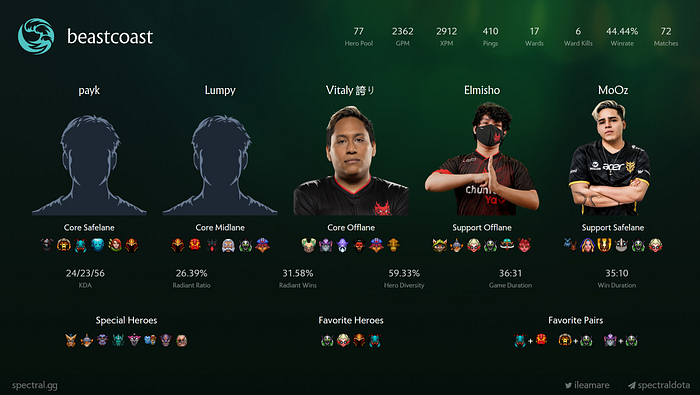
Beastcoast always tend to be under the radar and then pop out of nowhere, bringing some of the South American chaos with them. This time they bringed some new faces to the pro scene, including Payk: a young, promicing and flexible (one of the widest hero pools this month in ranked, compared to other TI players) player.
Their main staples are wild ideas and “run them down” approach (and they actually know how to do it, which is the important part). And weirdly enough, in the current patch and current meta it’s exactly the kind of approach that might bring them success. The team still is relatively new, and the individual performances are lacking in comparison to other teams, but who knows: maybe they will finish the run at a decent place?

BB Team
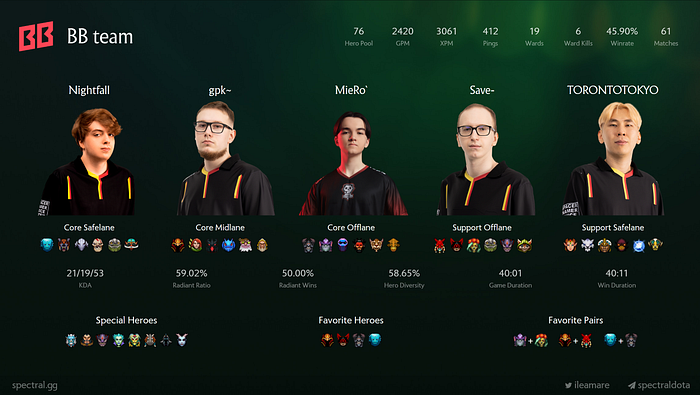
BB Team is weird. It feels like they are trying harder and harder to kind of replicate this TI Winner magic of Spirit, while also being more akin to Virtus.pro. And in all fairness, I can’t really say they fail at that: with every month they start to look more ane more promising as a team, more mature and possibly ready to take over the world.
Unlike Spirit, however, they tend to rush more into things instead of a more calculated approach, and tend to suffer from it. And despite this approach working well enough in the current meta in particular, it feels like the players didn’t quite feel it yet and feel too uncomfortable to let their potential out.

Xtreme Gaming

Xtreme Gaming are my favorite team and it’s definitely not because I have a crush on competitive Genshin player Ame.
If you will take IG and replace all their players with retired Dota superstars you will get Xtreme. Which also kind of has the spirit of the old LGD roster, I guess?
The two biggest stars of the team are XinQ and Ame, both being very strong individual performers with quite unique vision of the game and playstyles. Xtreme as a team tend to generally play into the current meta, but with their own twist on it. They love to play fast and aggressive, but doing it in a more methodical way. Ame loves to play “slower” heroes, but has a superpower of adapting them to high tempo. So in the end of the day Xtreme might end up being the most unique team to follow.
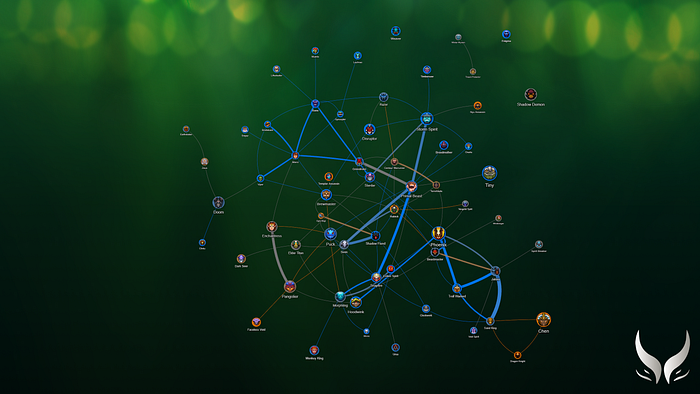
Tundra Esports

New Tundra roster is peculiar, but faced a lot of challenges since last TI: completely new roster, with all the players but one leaving the org, rocky start, unreasonable demands, visa issues, Deadlock invites. Everything seemed to work against them this year.
The graphic above features 9Class instead of Saksa, and this kind of showcases the biggest issue the team is facing: sudden roster change. Not to mention, this roster generally feels like a cheap knockoff version of the old squad.
With all that said, all players on this team are strong individual performers, they are all flexible in terms of their hero pools, positions and playstyles. They adapt well to new patches and it seems like they feel rather comfortable playing right now, with their “jump and disrupt” approach. The team shines the most while playing their highly trained drafts and making unconventional strategies work (which is a bit disturbing, considering they don’t have much time to bring Saksa up to speed with their strategies), but there is a chance they will rise from the ashes and show as great performance as ever, or even come out stronger.
Coming into TI13, they looked like one of the strongest contenders for the Aegis, so let’s hope they won’t lose their momentum.

Talon

To be completely honest, I forgot about Talon as a team for a moment and was surprised to see them pass through TI Qualifiers. We didn’t really see much from this team throughout the year, thus there isn’t much to say about them.
The team is very fresh and full of young players, and their general playstyle feels a bit more akin to a ranked match rather than a competitive game. This leads to some suprise picks, but this also leads to them blindly repeating trends set by other teams, struggling to catch up.
Two staples of the team are Mikoto, the experienced mentor and a very good performer himself, and Akashi, a very young carry player, who seems to be very gifted as a player. It’s hard to say how well their run will go, but if it goes well, I’d bet it’s because of these two.

Gaimin Gladiators

Gaimin have this “almost-but-not-quite-champs” curse. They were the menace of DPC’22, but didn’t end up winning that year. They were the menace of DPC’23 and everyone expected them to win TI12, but they came 2nd. If anything, this reminds me of LGD at TI10 a lot: similar storyline and a very similar outcome.
They still ended up winning “the other TI” this year in Riyadh, which is great. But every Dota player wants to lift the Aegis at least once in their life. This time people seemed to let their guard down a bit about Gaimin, slightly lowering their expectations and making the pressure easier to endure for the players.
One thing to note about their performance: they have 2nd highest diversity of picks in the last 4 months of competitive games, they tend to place a strong emphasis on laning, to later use this momentum to carry forward and snowball. This might also be their weak spot: if their plans fall apart, it’s usually much harder for them to adapt, compared to other teams. However, their plans are usually well calculated and executed to be easily broken.
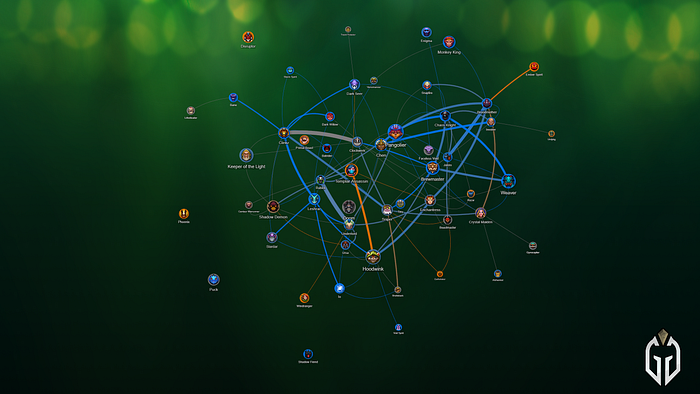
Cloud9

If it wasn’t for Xtreme, I would say Cloud9 are my favorites. And it’s also one of the strongest teams at TI13.
Cloud9 are hard workers, putting a strong emphasis on practice and analytics (with their brilliant analyst ChosenOne). This team is also one of the most diverse in terms of drafts (4th, with 70 heroes in the pool over 57 matches). And every player on the team is also famous for strong individual performance, not to mention the overall team chemistry, that ties everything together. This kind of roster is a great match to bring the glory to the legendary Cloud9 tag!
Their staples are creative drafts with strong preparation stage to every opponent, followed by early aggression, teamfights and strong emphasis on the fight flow control. This, too, works well enough with the current meta, but the team’s one of the stronger sides is their flexibility and ability to adapt, so I’m sure they won’t have any issues finding their jam.

nouns

For me personally Shopify Rebellion, Evil Geniuses and Nouns are sort of like spirits of Past, Present and Future of Christmas. Except it’s EG instead lf Christmas. And Nouns pretty much feels like a spiritual successor to the “original” EG, if it makes sense.
In part this feeling comes from the management, in part it comes from the latest addition of Fly. Some of it comes from the vibe. Honestly, it’s hard to put into words. But one thing is certain: nouns came a long way from “a random NA stack” to “wait they are actually pretty good”.
They are the most diverse team in my Pre-TI13 report (and also the team with 2nd widest hero pool: 87 over 100 matches). Their playstyle appears casual and slightly relaxed, but it’s just a mask for disciplined and efficient approach to the game. Before they were good at knowing their limits with aggression and having a good sense of time for objectives. Now, with Fly coming in with all his experience, as well as Yuma and Copy joining in as young stars, this roster seem capable enough to beat their own last year record.

Team Zero
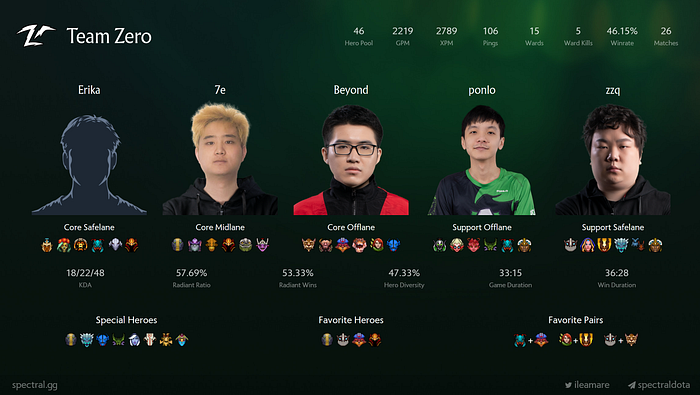
Team Zero has a fun name, because it reflects how much I knew about them. Honestly, the only thing in my book was that I heard nickname Ponlo before, but that’s about it. And yet they appeared out of nowhere just to take over TI Qualifiers.
The only thing to note about them so far is that they are a formidable foe. They seemed to practice a lot right before TI13, and they also seem to have a very good sense of meta. But it’s hard to evaluate their playstyle based only on their qualifier games.
I would not get my hopes up about Tz, but who knows. There are definitely some Wings vibes going on.

Team Falcons

We already had Tundra team on the list, now it’s time for The Real Tundra: also known as Falcons. Or rather whatever remained of it. After the team parted ways with Tundra the org, the roster had some changes. But it seems like these changes turned out well for Falcons, as their performance was stellar throughout this year.
Just like Tundra before, Falcons are seen as trend setters and known for their great sense of meta. There is also some great team synergy going on between ATF and skiter, as well as skiter and Sneyking. They are good at map control, as well as slow and methodical play. This might still become their problem, along with the “strong team curse”, but I would be optimistic about Falcons.

1W Team

1W look like a young a promising squad, but there are only Elite League S2 and TI Qualifiers to back it up for now. But HOW they back it up, man! This squad sure has made a name for itself by playing five matches in the grand finals of ELS2 against Team Liquid no less.
Their staples are flexibility (their hero diversity is 2nd after nouns) and somewhat pub-like drafts and performance. They clearly manage to make it work, and they seem to be adapting to the meta well enough. But in a way this team still remains a mystery, and I would not be surprised if throughout the group stage they would have great success, until someone finds a “key” to defeating them.

Heroic

Heroic is a solid roster, collecting all South American stars (and Davai Lama). Their placements at Tier 1 events do not look great, but they attended almost every significant event this year.
At the same time, there are a lot of great performing players, and their ranked stats show that they were putting the effort to prepare and improve for this TI. One of their signature cards is either flexing the roles, or picking heroes that are fluid in their position throughout the game. Heroic tend to be a chaotic force of nature, brawling non-stop, while also dragging the game for a bit.

Aurora Gaming

Aurora is the last team on the list, and while it has all the stellar players of the region (and effectively being the previous Talon roster), this team kind of went under the radar for many.
Generally speaking Aurora’s hero pool seem to work well in the current meta, especially with heroes like Omniknight, Visage, Drow and QoP. Staples of the team are flawless early rotations and great early game execution, however they always struggled with keeping this momentum up and not throwing the game. This season they sort of slowed down a bit, while still keeping up the early pressure as their preferred playstyle.

Closing thoughts
And that’s about it. With DPC system going away it was quite a bit harder to follow and understand some of the teams, but generally speaking it feels like the scene changed quite a bit and the change brought quite a bit of openness.
As always, a reminder: this blog post is more of my perception of the teams and their playstyles. I would still advice you to watch the games and make your mind about the teams yourself. And look at some pretty pictures here in the meantime.
I am also lucky enough to work at The International once again, so keep looking for some numbers and trivia coming from me on the English brodcast (Group Stage and Main Event). There might also be some on-site content in my Telegram channel or on Twitter, but no promises there.
Until the next time comes, you can follow me on Twitter or join my Discord. You can also make a donation here to support my projects if you like what I do and would like to help, I really appreciate that.
Also you can check out my overviews for older TIs
- TI12 Teams Overview
- TI11 Teams Overview
- TI10 Teams Overview
- (there were similar overviews for TI8 and TI9, but only exist in my personal archives for now)

